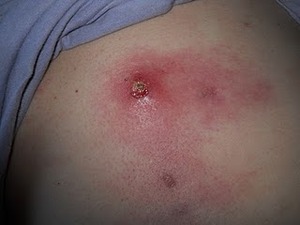I had promised an article regarding staph infection and all the things “they” don’t tell you. Considering the fact that I have only recently recovered from my latest trial with this illness, I figured now was as good a time as any to get this out there in the open. There are far too many misconceptions about staph. Some people are so in the dark that they either do not realize or cannot grasp the truth about how they or a loved one contracted staph infection. Still others, like my own mother, want to place the blame on dirt and pets. It’s time to lay those misconceptions to rest.
I know the above photo is graphic, but I want anyone who reads this to know what to look for with staph skin infections. They start out looking like zits… quickly, they look like a festering zit with no head, and they feel hard. Within days, you have this photo above.
Many beleieve that staph is something you contract in the hospital, due to open wounds, an impaired immune system, surgical snafus, etc. While this is one place where staph can be contracted, there are plenty of others. You can get it from coming into contact with someone who has it, especially an open, uncovered wound. Staph seems to run rampant in gym locker rooms as well. However, did you know that you can get staph from yourself? This is the nmost common source. We are all colonized with the staph bacteria. Staph aureus lives on our skin and in colonies in our noses (another good reason to encourage the kids and others not to be “digging for gold”). Some only carry it and never develop the infections from the bacteria. Others, like me, are susceptible to the infections and illness. In my case, it is due to diabetes and an impaired immune system.
There are several strains of staph infection.
- MRSA (methocillin-resistant) is the worst, and is resistant to all -cillin drugs.
- VRSA is the vancomycin (and other -mycins) resistant strain.
- My most recent battle was with MSSA, which, fortunately, is antibiotic sensitive.
- Still, other strains exist.
When staph was first discovered in my blood in 2004, following a long illness and sudden 106 degree fever, it was due to an open wound. I got sick, went to the hospital, stayed a week, came home and continued treatment... I thought I’d get better and that was it. No one told me about prevention, lingering effects, or recurrences I could encounter in the future. I thought my infection was a fluke; something that happened because an abusive boyfriend had bitten my arm right before we broke up, and I had an open wound when I cleaned a filthy rental house for a friend. These were certainly contributing factors, but the staph was already there,dormant and waiting for a chance to attack.
I was not on treatment long enough that first time. The hospital was more concerned about the bill being run up by the uninsured girl than about my health. (I have since changed hospital preferences to one that actually puts healthcare first.) No one warned me that my lungs and respiratory system would be permanently damaged. No one told me I would fight minor heart issues for years to come. No one told me that it would be an uphill battle to regain strength in my legs or that it would take nearly a year to feel like myself again or to have any energy whatsoever. No one told me that staph likes to linger in the body and that the initial infection was only the beginning of my woes.
By 2005, I was suffering from staph skin infections. They were small to large boils that appeared on most any part of my body. Some were relatively minor and would go away on their own. Others were extremely large and very painful, accompanied by fevers, vomiting and loss of appetite. These really took off by 2007, with the majority favoring my back. I’d get one or two of these large ones per year, with several small ones in the interim. I never thought much of it except that it meant yet another trip to the doctor or ER and more pills to take. (Oh Joy!)
My own research made me suspicious that I was still battling staph. However, I was dealing with a series of incompetent doctors, and the ER blew it off like it was nothing big, telling me that nothing could be done; we simply had to deal with incising, drainage and treatment with each new infection. (FUN, FUN!) So, now, it’s 2010, and I am already fed up with these things and the lack of answers. The one culture done on these infections was never revealed to me, though I asked for the results, and I am positive that, sitting in a file somewhere, is a lab report from 2007 or 2008, that explicitly states that these heinous little flesh eating bubbles are, in fact, the result of staph infection. Someone has known all along, but again, nothing was being done.
Since January of 2010, I have had 12-15 of these things. Honestly, I lost count after number 5. ER visits, pain, scalpels and pills seemed to have become a monthly to bi-monthly routine. In a 3 week period, between November and December of 2010, I had 4 outbreaks. Just when the first two were healing, I developed severe lower back pain and suddenly had one appear on my lower back and another on my left shoulder. These flared up fast. The pain was awful and the symptoms were worse than before. I could hold nothing down, had bad fevers, no appetite really and some weight loss.
I finally called my dad for a 4:30 am ride to the hospital. This time, I lucked out. I got a doctor who cared, ran all the tests and admitted me due to an elevated white blood cell count. My own doctor, whose office had been forcing me to see someone else, appeared and is now fully involved. I am feeling better and am hoping that this spells the end of this long battle with staph. Nevertheless, we will see.
Something others need to know? Protect yourself! Cover all wounds. Stay out of contact with other people’s wounds, unless you wash and wash good. Cover your mouth when in contact, as staph can be airborne. Practice good personal hygiene and see a doctor regularly. If you notice a skin infection, get it looked at and demand tests before it is too late. The pain is such that I do not know how one could go very long without treatment; however, if you do, you are in greater danger. Staph skin infections, if and when they breach the subcutaneous level, can get into your blood stream. The one on my lower back, had it been deeper, could have led to osteo-meningitis. If you do develop a staph skin infection, get it treated and keep it covered. Don’t put others at risk!
Two other things “they” won’t tell you. See your doctor instead of the ER, if you can, or go to the ER armed with information to make demands. I was being placed on Keflex and Bactrum. These antibiotics are NOT suited for staph. Also, if it is staph, you need to wait until the wounds heal and then wash your body as instructed with hep wash for 10 days and swab your nose with bactroban for 7-10 days as well. This helps to decolonize the staph. The ER is more concerned with treating your immediate pain and getting you out the door; the root cause and long-term prevention is not their priority.
The bottom line, do your homework and take care of yourself. No infection or illness is worth playing around with. Staph infection can be deadly! However, it is also very treatable for those who are proactive and do not take risks with their healthcare.
I have been staph-free for 8 months, knock on wood. Thanks to the use of Hibacleanse and antibiotic ointment in my nose, I have kept the evil staph at bay. No one has to suffer from recurring staph infections. They simply need to know what it is, what causes it, and how to prevent it.





